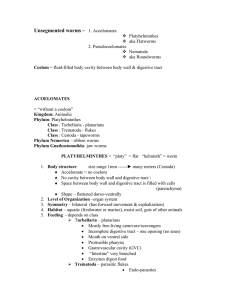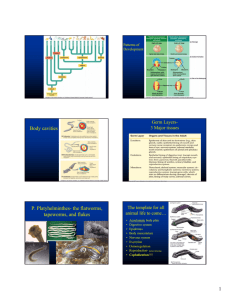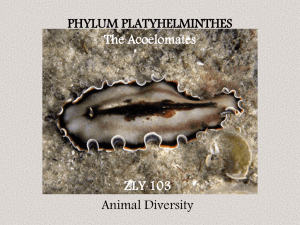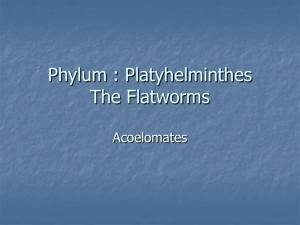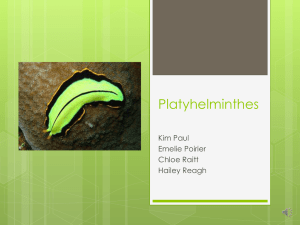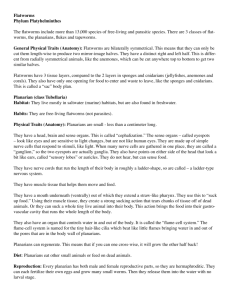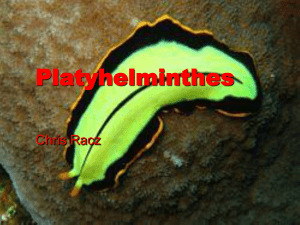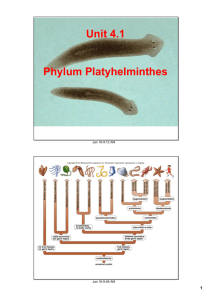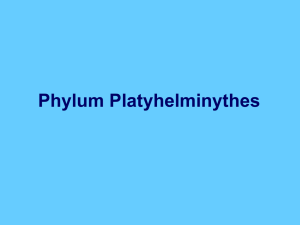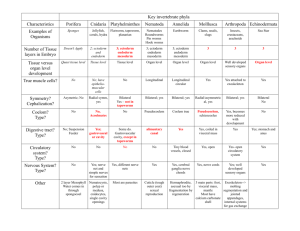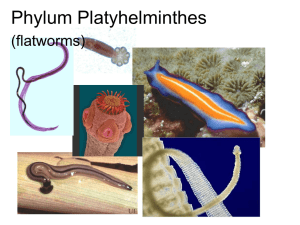Phylum Platyhelminthes AKA Flatworms (3)
advertisement
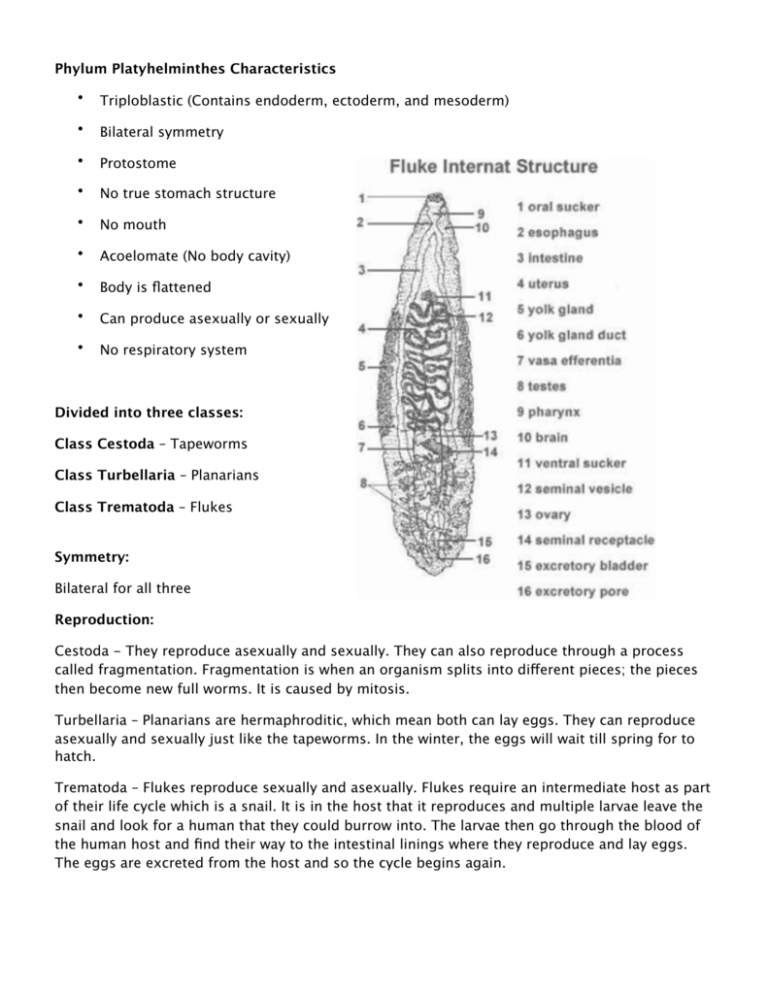
Phylum Platyhelminthes Characteristics • Triploblastic (Contains endoderm, ectoderm, and mesoderm) • Bilateral symmetry • Protostome • No true stomach structure • No mouth • Acoelomate (No body cavity) • Body is flattened • Can produce asexually or sexually • No respiratory system Divided into three classes: Class Cestoda – Tapeworms Class Turbellaria – Planarians Class Trematoda – Flukes Symmetry: Bilateral for all three Reproduction: Cestoda - They reproduce asexually and sexually. They can also reproduce through a process called fragmentation. Fragmentation is when an organism splits into different pieces; the pieces then become new full worms. It is caused by mitosis. Turbellaria – Planarians are hermaphroditic, which mean both can lay eggs. They can reproduce asexually and sexually just like the tapeworms. In the winter, the eggs will wait till spring for to hatch. Trematoda – Flukes reproduce sexually and asexually. Flukes require an intermediate host as part of their life cycle which is a snail. It is in the host that it reproduces and multiple larvae leave the snail and look for a human that they could burrow into. The larvae then go through the blood of the human host and find their way to the intestinal linings where they reproduce and lay eggs. The eggs are excreted from the host and so the cycle begins again. Coelom development: Class Cestoda – Protostome Class Turbellaria – Protostome Class Trematoda – Protostome Levels of organization: Cestoda –Tapeworms is covered with cuticle, with a soft ribbon like body which is flattened. They lack of a respiratory system and a circulatory system but they do contain a nervous system. They are characterized by three germ layers which are ectoderm, mesoderm, and endoderm. Turbellaria –Planarians has one opening. They lack a respiratory system but they have an excretory system which is mainly used for water regulation. The excretory system contains flame cells. Flame cells moves excess water into tubes that open to the outside. They are characterized by three germ layers which are ectoderm, mesoderm and endoderm. It has a gastrovascular cavity which digestion occurs. Trematoda – Flukes contain the same body form and digestive cavity as Turbellaria. Practically, the entire interior is occupied by the reproductive system. They have three germ layers which are ectoderm, mesoderm and endoderm. Flukes have a leaf-shape and an outer cover called the tegument. Cephalization: Cestoda - A small head AKA Scolex Turbellaria – A triangle shaped head with ganglia Trematoda – Has ganglia in the head region (ganglia is a mass of nerve cells) Feeding: Cestoda – Tapeworms absorbs the digested food and nutrients from the host’s intestines through its body wall. Turbellaria – Planarians are nonparasitic worms and it mainly feeds on crustaceans, larvae and small worms. The Turbellaria extends a long and tubular pharynx that is located underneath and at the centre of the Planarian’s underside. Trematoda – The Flukes digests the host’s blood, mucus, tissues and intestinal debris through the oral sucker that surrounds the anterior of the mouth, or ventral sucker. Respiration: Cestoda –No respiratory system but when oxygen is available, the general body lining works as the respiratory surface. Turbellaria – No respiratory system, the oxygen and carbon dioxide is through the cell wall of the planarians. Trematoda – No respiratory system Internal transport: Cestoda – Tapeworms doesn’t contain a circulatory system thus they depend on diffusion. Turbellaria – Just like tapeworms, Planarians depend on simple diffusion. Trematoda – Flukes don’t have a circulatory system, so they depend on diffusion. (Diffusion is the transport of solute from higher concentration to lower concentration) Excretion: Cestoda – Tapeworms use the same route when disposing waste and when they “feed” by absorbing their nutrients through their body wall. Turbellaria – Planarians uses the pharynx to dispose of waste (through the same structure as when they feed). Trematoda – The way that Trematodes get rid of waste products is through a well developed excretory system. The system, which is protonephridial, consists of flame cells which are conjoined to tubules that open into ducts that end in the bladder. This part of the excretory system is involved with osmoregulation. Waste is also excreted through the tegument. Response and motility: In all three, the motility is using muscles to twist and cilia to glide. Some flatworms have lightsensing eyes called ocelli that allow them to either move away or towards the light such as the Turbellaria.
